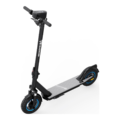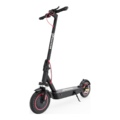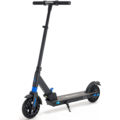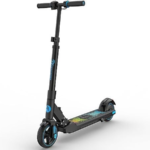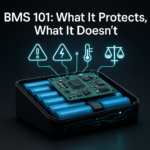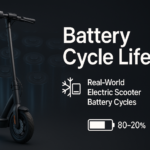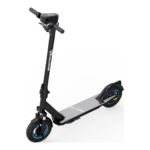- Home
- Scooters
- Electric Scooters
- EVERCROSS H5
EVERCROSS H5
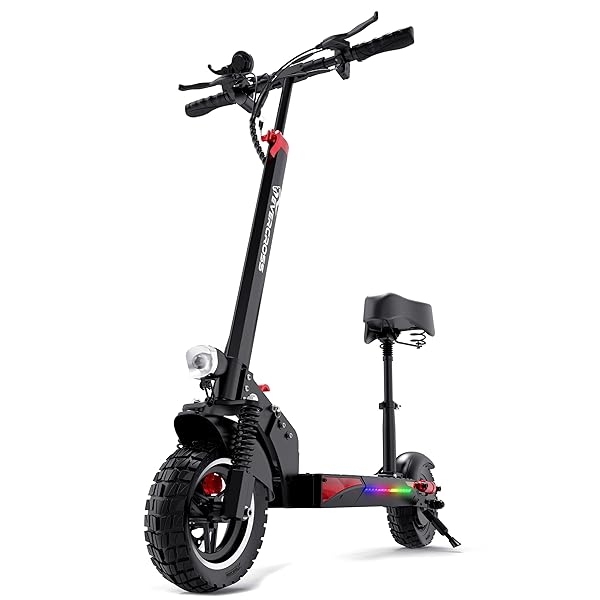

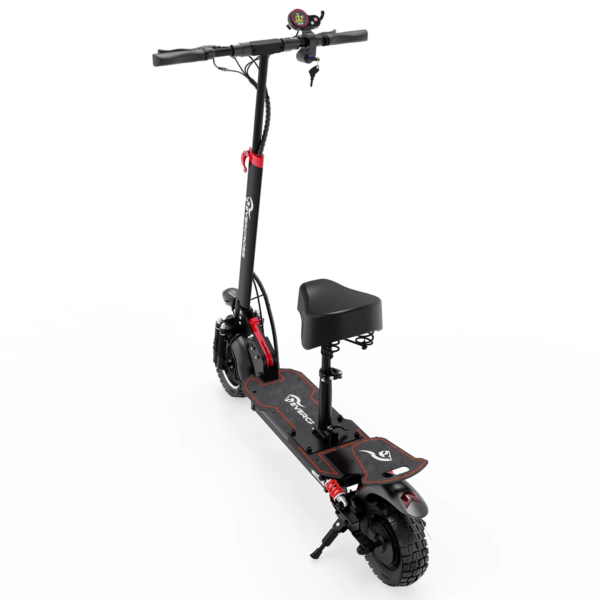

- Battery Range: 20–28 miles (32–45 km)
- Top Speed: 28 mph (45 km/h)
- Motor Power: 800 W (peak), 500 W rated
- Weight Capacity: 330 lb (150 kg)
- Charging Time: ~6–8 h
- Scooter Weight: 61.7 lb (28.0 kg)
PROS
- 28 mph top speed
- 10″ solid tires for puncture resistance
- Front & rear disc brakes
- Seat included/compatible
- Heavy-duty 330 lb (150 kg) capacity
CONS
- Heavy to carry
- Solid tires ride harsher
- IP rating not specified
Table of contents
- What Is the EVERCROSS H5?
- How the EVERCROSS H5 Works
- Key Specifications
- Design & Build Quality
- Performance Fundamentals
- Battery, Range & Efficiency
- Ride Quality & Comfort
- Braking & Safety Features
- Portability & Daily Usability
- Maintenance & Care
- Weather & Seasonal Considerations
- EVERCROSS H5 vs Alternatives
- Who the EVERCROSS H5 Is (and Isn’t) For
- FAQs
- Glossary
The EVERCROSS H5 is a robust, adult-class electric scooter built for riders who want extra stability, a detachable seat option, and confident braking without spending a fortune. It pairs a strong 800-watt rear hub motor with a 48-volt battery, 10-inch solid tires, dual suspension, and dual disc brakes. Because it balances pace, comfort, and practicality, the EVERCROSS H5 suits short urban commutes, campus hops, and weekend fun on mixed city paths.
What Is the EVERCROSS H5?
At its core, the EVERCROSS H5 is a single-motor, rear-wheel-drive e-scooter designed for adults. It emphasizes easy control, steady cruising, and low-maintenance ownership. The package typically includes a removable seat, so you can stand for agile city weaving or sit for longer neighborhood rides. With 10-inch solid rubber tires and dual spring suspension, the H5 aims to smooth out rough pavement while avoiding flats. Moreover, its keyed ignition, bright lighting, and dual disc brakes add security and safety essentials many budget scooters skip.
How the EVERCROSS H5 Works
Think of the H5 as a compact electric drivetrain wrapped in a folding frame.
- Motor: A brushless rear hub motor rated at 800 W provides acceleration and hill assistance. Because the motor sits inside the rear wheel, power goes straight to the ground with minimal loss and no chain to maintain.
- Controller: A small electronic controller meters battery power to the motor. When you twist the thumb throttle, the controller blends your input with speed mode settings and safety cutoffs. It’s the scooter’s “brain,” regulating current for smooth takeoffs and stable cruising.
- Battery: A 48 V, 10 Ah lithium-ion pack (approximately 480 Wh) sits within the deck. It supplies energy to the motor, lights, and display. Charge it with the included 54.6 V / 2 A charger; typical full charges take 4–7 hours.
- Throttle & Display: The LCD throttle module shows speed, battery bars, odometer, trip distance, voltage, and ride time. It also offers adjustable start mode (kick-to-start or zero-start), three speed levels, and cruise control. After holding a steady speed for a few seconds, cruise locks in; braking cancels it.
- Brakes: Front and rear disc brakes deliver strong, predictable stopping. The motor also cuts power the instant you pull a lever. That electronic cutout shortens stopping distance and avoids accidental throttle while braking.
Because each part is simple and accessible, day-to-day riding feels straightforward: power on, pick a speed mode, push off (or use zero-start), then modulate the throttle and brakes like a bicycle with a boost.
Key Specifications
Dimensions and performance figures are manufacturer-stated or drawn from official materials. Real-world results vary with rider weight, terrain, temperature, tire pressure, and maintenance.
| Section | Item | Value |
|---|---|---|
| General | Model | EVERCROSS H5 |
| Intended rider | Adult | |
| Max load | 330 lb (150 kg) | |
| Seat | Detachable (package dependent) | |
| IP rating | Not specified (avoid heavy rain) | |
| Performance & Power | Motor | 800 W brushless rear hub |
| Top speed (mode-dependent) | Up to 28 mph (45 km/h) | |
| Drive | Rear-wheel drive | |
| Speed modes | 3 selectable | |
| Battery, Charging & Electrical | Battery | 48 V, 10 Ah (≈ 480 Wh) lithium-ion (18650 cells) |
| Charger | 54.6 V / 2 A | |
| Charge time | 4–7 hours | |
| Claimed range | Up to 25 miles (40 km) | |
| Display | LCD throttle with speed, ODO/TRIP, voltage, time, errors | |
| Start modes | Kick-to-start or zero-start (selectable) | |
| Cruise control | Yes (long-press/steady speed hold) | |
| USB port | Low-current device top-ups (≤0.5 A typical) | |
| Build & Dimensions | Tire type & size | 10 in (25.4 cm) solid rubber |
| Suspension | Dual spring (front & rear) | |
| Brakes | Front + rear disc brakes (motor power cut on lever pull) | |
| Frame | Alloy steel main structure with aluminum components | |
| Vehicle weight | 44 lb (20 kg) | |
| Unfolded dimensions (L×W×H) | 49.6 × 8.7 × 45.7 in (126 × 22 × 116 cm) | |
| Folded dimensions (L×W×H) | 49.4 × 12.4 × 17.3 in (125.5 × 31.5 × 44 cm) | |
| Safety & Control | Lighting | LED headlight, tail/brake light, side reflectors; deck accent lighting |
| Horn/Bell | Electronic horn (varies by kit) | |
| Ignition | Keyed power switch | |
| Features & Extras | Folding | Stem latch with secondary safety catch |
| Handlebar | Height-adjustable | |
| Stand | Integrated kickstand | |
| Cruise Control | Included via display settings | |
| Warranty & Compliance | Warranty | Limited warranty (keep proof of purchase; terms vary by region) |
| Compliance | Consumer electronics labeling (e.g., CE/FCC markings) |
Design & Build Quality
The EVERCROSS H5 looks purposeful. The stem is tall and straight, the deck is long, and the ride triangle places weight over the rear wheel for traction. Fit-and-finish sits above typical budget tiers: welds are tidy, the deck rubber is grippy, and the fenders resist flexing. Because the wiring routes along the stem and under the deck, nothing snags your shoes.
The cockpit is simple. On the right, the LCD throttle shows speed, battery, and trip info clearly. On the left, a brake lever and horn control (if equipped) sit within easy reach. You can adjust handlebar height for a better arm angle, which reduces fatigue on longer rides. Moreover, the stem latch closes with a firm snap and a secondary safety to prevent accidental fold-downs.
Down low, 10-inch solid tires and dual shocks define the chassis feel. Solid rubber avoids flats and punctures. As a result, you trade some softness for convenience, yet the twin springs help take the sting out of patched asphalt and curb cuts. Combined with the long deck, the H5 gives you enough foot room to switch stances during a ride.
Performance Fundamentals
In everyday use, the EVERCROSS H5 feels eager off the line in higher speed modes. The 800-watt motor delivers a firm push from walking speed to 15 mph (24 km/h). Because the controller meters power smoothly, throttle modulation stays predictable; you can feather in speed without jerks.
At cruising pace, the scooter tracks straight. The tall stem and long wheelbase add stability, especially at 18–22 mph (29–35 km/h). However, like most narrow-deck scooters, wind gusts and rough patches still require a relaxed but alert grip. On modest 7–10% grades, the H5 climbs steadily if you enter with momentum. Expect pace to drop as slope, rider weight, and battery state stack up. Shifting to a middle speed mode often maintains a smooth cadence while preserving temperature headroom for the motor.
Under hard acceleration on imperfect pavement, the front end remains composed. Nevertheless, if you feel any high-speed shimmy, check tire condition, stem latch tightness, and handlebar clamp torque. Those quick checks solve the overwhelming majority of wobble complaints.
Battery, Range & Efficiency
The H5’s 48 V, 10 Ah pack stores roughly 480 watt-hours. In ideal conditions, that supports up to 25 miles (40 km) of gentle riding with conservative throttle. Realistically, most adults will see 14–22 miles (23–35 km) depending on weight, hills, surface friction, and wind. Because solid tires roll harder than pneumatics, riding posture and smooth throttle habits matter more than you might expect.
To stretch range, accelerate briskly to your target pace, then hold steady. Cruising in the middle speed mode reduces voltage sag and heat, which improves efficiency. Additionally, keep bearings and brake rotors aligned to avoid drag, and recheck deck screws if you hear rattle that might mask a rubbing brake.
Charging best practices
- Let the scooter cool 15–20 minutes before charging after a hard ride.
- Use the 54.6 V / 2 A charger on a stable outlet; full charges typically take 4–7 hours.
- For storage over a week, leave the pack around 50–70% and top it up monthly.
- Avoid full discharges; lithium-ion batteries prefer partial cycles.
- Store between -4°F and 104°F (-20°C to 40°C); charge above 50°F (10°C) for battery health.
Ride Quality & Comfort
The H5 is tuned for city pavement and park paths. Solid 10-inch tires plus dual springs yield a firm but controlled ride. You’ll feel smaller joints and coarse chip seal, yet the suspension prevents harsh bottom-outs on moderate potholes. Because the deck sits at a comfortable height, you can alternate between diagonal and snowboard-style stances to relax calves on longer trips.
Handlebar height adjustability helps taller riders open the shoulder angle. Consequently, wrists stay neutral, and steering inputs become lighter. The stem exhibits modest flex only during big hits; on clean streets, it stays reassuringly rigid. Combined with the long deck and rear-biased weight, the EVERCROSS H5 isolates vibration better than many no-suspension commuters.
Braking & Safety Features
Dual disc brakes are the star here. Lever feel is progressive, with a firm bite halfway through the pull. On dry asphalt, you can brake harder than most standing scooters allow without locking both wheels. The motor’s electronic cutoff prevents throttle overlap, which increases stability during emergency stops.
Lighting covers the essentials. A forward LED headlight improves conspicuity at dusk, and the tail light brightens under braking. Side reflectors and deck accent LEDs boost 360° visibility. Even so, for true night riding, add a brighter bar-mounted light and a reflective vest. Because no official IP rating is listed, treat water with caution: slow down around standing water and store the scooter indoors.
Extra safety niceties include a keyed ignition that deters casual tampering and a loud electronic horn on many builds. As always, match your speed to sightlines, give pedestrians space, and ride predictably.
Portability & Daily Usability
At 44 lb (20 kg), the EVERCROSS H5 is portable enough for short carries but heavy for multi-flight stair climbs. The folding stem locks down quickly; the secondary latch prevents surprise openings. Because the folded size is 49.4 × 12.4 × 17.3 in (125.5 × 31.5 × 44 cm), it slides into a trunk, under a desk, or against a hallway wall. The unfolded footprint—49.6 × 8.7 × 45.7 in (126 × 22 × 116 cm)—fits standard bike racks if you prefer a cable-through-frame lock while you’re nearby.
Daily habits that help:
- Bring the charger to work; mid-day top-ups are quick at 2 A.
- Use the seat for longer rides; remove it for busier, stand-up weaving.
- Lock through the frame and rear wheel if you must park outside, and avoid leaving it unattended for long periods.
- Wipe dust from the display and check the latch before each ride.
Maintenance & Care
Even a low-maintenance scooter benefits from a simple routine. Here’s a practical schedule:
Before each ride (60 seconds)
- Squeeze both brake levers; confirm firm feel and rotor alignment.
- Check the stem latch and safety catch.
- Glance at the tire surfaces for cuts or embedded debris.
- Confirm battery level and speed mode.
Weekly (5–10 minutes)
- Inspect rotor bolts, caliper mounts, and axle nuts; snug if needed.
- Wipe dirt from the deck rubber for secure footing.
- Verify that the display buttons click consistently.
Monthly (15–20 minutes)
- Clean and lube the folding latch pivot (dry PTFE lube works well).
- Re-center calipers and bed pads if stopping power fades.
- Check all visible screws: fenders, handlebar clamp, stem cap, kickstand, and seat post clamp.
- Review the display settings: ensure cruise, start mode, and units are correct.
Tires
Solid rubber eliminates flats, yet pressure checks aren’t needed. Still, examine tread for chunking or cracks, and replace the tire if you see significant damage or the ride becomes noticeably harsh.
Firmware/App
The H5’s LCD module is hardware-controlled. There’s no dedicated app to babysit, which keeps upkeep simple and privacy-friendly.
Weather & Seasonal Considerations
Because the EVERCROSS H5 doesn’t publish an IP rating, treat wet weather conservatively.
- Rain: Ride slower on paint lines, manhole covers, and smooth concrete. Water reduces rubber grip more than you think. Avoid puddles deeper than the rim and never blast the deck with a hose.
- Cold: Lithium-ion chemistry loses capacity in the cold. Expect range to drop when temperatures fall below 50°F (10°C). Pre-warm the scooter indoors and ride in a moderate speed mode.
- Heat: In hot weather, shade the parked scooter and avoid top-speed sprints up long hills. If the deck feels unusually hot, give it a rest before charging.
- Storage: For multi-month storage, leave the battery near half charge and top it up monthly. Keep it dry, clean, and away from direct sun.
EVERCROSS H5 vs Alternatives
Within its price class, the EVERCROSS H5 sits between lightweight commuters and high-Within its price class, the EVERCROSS H5 sits between lightweight commuters and high-performance dual-motor machines. If you’re cross-shopping, lightweight entry commuters such as the EVERCROSS EV08E and compact beginner-friendly options like the EVERCROSS E8 emphasize portability and simplicity over raw power.
- Versus slim commuters: The H5 brings more power, larger 10-inch wheels, real suspension, and dual disc brakes. It’s heavier and bulkier, yet far more planted at 20+ mph (32+ km/h).
- Versus performance scooters: It’s simpler, lighter, and less demanding than big dual-motor models. You give up extreme acceleration and long-range batteries, but you gain ease of handling, manageable weight, and lower upkeep.
- Versus “off-road styled” cruisers: The H5 looks rugged and rides comfortably on poor pavement. However, knobby-tire trail rigs still outperform it on dirt climbs and rocky paths. The H5’s solid tires and single motor favor urban terrain with the occasional park shortcut.
When your routes mix bike lanes, neighborhood streets, and rough patches, the EVERCROSS H5 excels. If you regularly tackle very steep hills or ride 30+ miles in a day, a larger battery or dual-motor platform will fit better.
Who the EVERCROSS H5 Is (and Isn’t) For
Great for:
- Commuters up to 330 lb (150 kg) who want stable brakes and a comfortable stance.
- Students and staff crossing large campuses where a seat is welcome.
- Last-mile riders who value flat-proof solid tires and straightforward controls.
- Multi-modal travelers who need a scooter that folds cleanly into a trunk.
Not ideal for:
- Riders needing app-connected security or advanced telemetry.
- People with multi-flight stair carries; 44 lb (20 kg) gets heavy fast.
- Steep-hill regulars or off-road enthusiasts who need dual-motor traction.
- Rain-or-shine daily riders; with no stated IP rating, caution is prudent.
FAQs
1) How fast does the EVERCROSS H5 go?
In high mode on level ground, it can reach up to 28 mph (45 km/h). Always ride within local limits and your comfort zone.
2) What range should I expect from one charge?
Plan on 14–22 miles (23–35 km) for typical adult riders on mixed city routes. Gentle throttle and smoother surfaces extend range.
3) Does the EVERCROSS H5 have cruise control?
Yes. Hold a steady speed for a few seconds to engage cruise; touching the brake disables it.
4) Are the tires pneumatic or solid?
They are 10-inch solid rubber tires. You won’t need to check pressure, and pinch flats aren’t an issue.
5) Can I start from a standstill without kicking?
You can choose zero-start in the display settings or use kick-to-start for extra safety.
6) Which brakes does it use?
The scooter has front and rear disc brakes with electronic motor cutoff when you pull a lever.
7) Where can I find an “EVERCROSS H5 overview” in short form?
Check the Key Specifications table above; it summarizes the essentials in a compact format for quick reference.
Glossary
- Ah (Amp-hours): Battery capacity measure. Higher Ah means more energy at the same voltage.
- Wh (Watt-hours): Total stored energy (volts × amp-hours). Better for comparing batteries.
- Brushless hub motor: Motor built into the wheel; efficient, quiet, and low maintenance.
- Controller: Electronics that regulate motor power and protect the system.
- Cruise control: Feature that maintains a set speed until you brake or adjust throttle.
- Disc brake: Steel rotor with caliper and pads; strong, consistent stopping.
- E-cutoff: Automatic motor power cut when braking; prevents throttle-brake overlap.
- Kick-to-start: Requires a small push before throttle engages; avoids accidental takeoffs.
- Zero-start: Allows throttle from a standstill; convenient but requires caution.
- Stem flex: Minute bending in the handlebar tube under load; affects high-speed feel.
- IP rating: Ingress Protection code for dust/water resistance; not listed for the H5.
- Voltage sag: Temporary drop in voltage under load; increases with high power draw.
- Bed-in: Process of wearing brake pads and rotors together for optimal bite.
- Wheelbase: Distance between wheel centers; longer wheelbases ride more stably.
- Mode: Speed/power preset that changes acceleration and top speed.
Specifications
General
| Model The Model specifies the exact version or name of the scooter. It helps identify its unique design, features, and specifications within the manufacturer’s product line. Knowing the model makes it easier to compare options, find compatible accessories, or look up support information. | H5 |
| Brand The Brand identifies the manufacturer or company that designs and produces the scooter. A trusted brand is a sign of quality, reliability, and good customer support. Well-known brands often have higher standards for safety, performance, and after-sales service, giving you more confidence in your purchase. | EVERCROSS |
| Release Date The Release Date indicates when the scooter model was officially launched on the market. This helps you know how current the design, technology, and features are. A newer release date often means updated components, improved performance, and the latest safety or smart features. | 17 November 2025 |
| Recommended Age Recommended Age indicates the minimum age range that the scooter is designed for, based on safety, size, and ease of use. Following the recommended age helps ensure that riders can handle the scooter’s speed, weight, and controls comfortably and safely. Always check local laws and use protective gear, especially for younger riders. | +16 |
Performance & Power
| Motor Power (Wattage) What it means: The motor power, measured in watts (W), shows how strong the scooter’s electric motor is. Why it matters: Higher wattage usually means better acceleration, more torque, and improved performance on hills or rough terrain. For example, a 250W motor is good for flat city roads and light riders, while a 500W or 1000W motor provides more power for faster speeds or climbing steep inclines. | 800 W peak (500 W rated) hub motor |
| Top Speed The Top Speed indicates the maximum speed that the scooter can reach under optimal conditions. It’s usually measured on level ground with a fully charged battery and an average rider weight. A higher top speed allows you to travel longer distances faster, but always ensure you ride within legal speed limits and your personal comfort zone for safety. | 28 mph (45 km/h) |
| Battery Capacity Battery Capacity refers to the total amount of energy the scooter’s battery can store, usually measured in ampere-hours (Ah) or watt-hours (Wh). A higher battery capacity means you can ride longer distances on a single charge, reducing the need for frequent recharging. Keep in mind that actual range can vary depending on rider weight, terrain, speed, and weather conditions. | 48 V 10 Ah (480 Wh) |
| Estimated Range per Charge The Estimated Range per Charge indicates the average distance the scooter can travel on a single full battery charge. This range is calculated under optimal conditions, such as flat terrain, moderate speed, and average rider weight. Real-world range may vary depending on riding style, terrain, weather, and load. A longer range means fewer recharges and greater freedom for longer trips. | 20–28 miles (32–45 km) |
| Hill Climb Ability Hill Climb Ability describes the maximum incline or slope that the scooter can handle while maintaining stable performance. It’s typically expressed as a percentage or in degrees. A higher hill climb rating means the scooter can tackle steeper hills without losing too much speed or power. Actual climbing performance may vary based on rider weight, battery charge, and terrain conditions. | Not specified |
| Drive System The Drive System refers to how power from the motor is delivered to the wheels. Electric scooters typically use either a hub motor (directly integrated into the wheel) or a chain/belt drive system. A high-quality drive system ensures smooth acceleration, efficient power transfer, and low maintenance. The choice of drive system affects performance, noise level, and overall ride experience. | Not specified |
Charging & Electrical
| Charging Time Charging Time indicates how long it takes to fully recharge the scooter’s battery from empty to 100% using the standard charger provided. Faster charging means less downtime and more time on the road. Actual charging time may vary slightly depending on battery capacity, charger output, and environmental conditions. | Approx. 6–8 hours |
| Battery Type Battery Type refers to the specific technology used in the scooter’s battery, which affects performance, lifespan, weight, and charging time. Most modern electric scooters use high-quality lithium-ion (Li-ion) batteries because they offer a good balance of energy density, durability, and low maintenance. A reliable battery type ensures consistent power delivery and longer riding ranges. | Lithium-ion battery |
| Removable Battery A Removable Battery means the battery pack can be easily detached from the scooter for convenient charging and replacement. This feature allows you to charge the battery separately, swap it with a spare for extended range, or securely store it indoors in extreme weather. Removable batteries add flexibility and make it easier to keep your scooter powered up wherever you are. | Non-removable internal battery (fixed pack) |
| Regenerative Braking Regenerative Braking is an energy-saving feature that converts some of the energy normally lost during braking back into battery power. When you slow down or brake, the motor works in reverse to generate electricity, which helps extend the scooter’s range and improves overall efficiency. This system also reduces wear on traditional brake components, leading to lower maintenance over time. | Not specified |
| Lighting Lighting refers to the built-in front and rear lights that enhance visibility and safety when riding in low-light conditions or at night. Good lighting helps you see the road ahead and ensures that other road users can see you. Many scooters include LED headlights, taillights, and sometimes brake lights or side reflectors for added safety and compliance with local traffic regulations. | LED headlight, rear/brake light, deck accent lights |
Build & Dimensions
| Scooter Weight Scooter Weight refers to the total weight of the scooter when fully assembled, including the battery. This affects how easy it is to carry, lift, and store the scooter when not in use. A lighter scooter is more portable and convenient for commuting, especially if you need to carry it upstairs or onto public transport. Keep in mind that a sturdy frame and quality components may add to the weight but also contribute to better durability and ride stability. | 61.7 lb (28.0 kg) |
| Maximum Rider Weight Maximum Rider Weight indicates the highest rider weight that the scooter is designed to safely support while maintaining optimal performance and stability. Staying within this limit helps ensure reliable acceleration, braking, and climbing ability, and it protects the frame, suspension, and motor from excessive strain. Exceeding the recommended limit may reduce performance and increase wear on components. | 330 lb (150 kg) |
| Deck Size Deck Size refers to the dimensions of the scooter’s standing platform. A wider and longer deck provides more foot space, allowing you to stand comfortably and adjust your stance while riding. A well-sized deck improves balance and stability, especially on longer rides or at higher speeds. Compact decks, on the other hand, help keep the scooter lightweight and portable. | Sturdy frame; seated-ready deck |
| Handlebar Height Handlebar Height refers to the distance from the deck to the handlebars, which affects your riding posture and comfort. An appropriate handlebar height helps you maintain good balance, reduces strain on your back and arms, and makes steering more comfortable. Some scooters have adjustable handlebars to fit riders of different heights, while others have a fixed height for a streamlined design. | Fixed |
| Folding Mechanism The Folding Mechanism describes how easily and securely the scooter can be folded for carrying and storage. A well-designed folding system lets you quickly collapse the scooter into a compact size, making it convenient to transport on public transit, store under a desk, or fit into a car trunk. Look for sturdy latches and safety locks to ensure the scooter stays firmly in place when folded or unfolded. | One-step fold with latch |
| Dimensions Folded Dimensions indicate the size of the scooter when it’s fully folded. This measurement shows how much space the scooter will take up when stored or carried, making it easier to check if it will fit in your car trunk, under a desk, or in a closet. Compact folded dimensions are ideal for commuters who need to bring their scooter on public transport or store it in tight spaces. | Unfolded: 49.6 × 8.7 × 45.7 in (126.0 × 22.0 × 116.0 cm); Folded: Not specified |
| Material Material refers to the primary construction materials used for the scooter’s frame and key components. High-quality materials like aircraft-grade aluminum, reinforced steel, or durable composites provide strength, stability, and a lighter overall weight. A sturdy material ensures the scooter can handle daily wear and tear while maintaining safety and performance. | Alloy steel |
Safety & Control
| Brake Type(s) Brake Type(s) describe the braking systems the scooter uses to help you slow down or stop safely. Common brake types include mechanical brakes (like drum or disc brakes), electronic brakes, and foot brakes. Many scooters combine multiple braking systems for added safety and shorter stopping distances. The type and quality of brakes affect your control, especially when riding at higher speeds or on slopes. | Front & rear mechanical disc brakes |
| Suspension Suspension refers to the system that absorbs shocks and vibrations while riding, providing a smoother and more comfortable ride over uneven or rough surfaces. Scooters may have front suspension, rear suspension, or dual suspension for better shock absorption and stability. Good suspension helps reduce rider fatigue and improves control, especially when riding on bumpy roads or off-road paths. | Front & rear suspension |
| Tire Type Tire Type refers to the kind of tires the scooter uses, which directly affects ride comfort, traction, and maintenance. Common types include solid (airless) tires, pneumatic (air-filled) tires, or hybrid options. Pneumatic tires offer better shock absorption and a smoother ride on rough surfaces, while solid tires are puncture-proof and require less upkeep. The right tire type helps ensure safe handling and a comfortable ride in different conditions. | 10″ solid off-road tires |
| Tire Size Tire Size indicates the diameter and width of the scooter’s tires, which affect ride comfort, stability, and how well the scooter handles different terrains. Larger tires generally offer better shock absorption and a smoother ride over bumps and rough surfaces, while smaller tires keep the scooter lighter and more portable. Choosing the right tire size helps ensure a balance between agility and comfort. | 10-inch |
| Kickstand The Kickstand is a built-in stand that allows you to park your scooter upright when it’s not in use. A sturdy kickstand keeps the scooter stable and prevents it from tipping over, protecting it from scratches and damage. It also makes storing and accessing your scooter more convenient, whether you’re at home, work, or on the go. | Side kickstand |
| Water Resistance Rating Water Resistance Rating indicates how well the scooter is protected against water and moisture, usually shown as an IP (Ingress Protection) rating. This rating helps you understand whether the scooter can handle light rain, splashes, or wet roads without damage. While most scooters are not fully waterproof, a good water resistance rating adds peace of mind when riding in changing weather conditions. Always avoid deep puddles or submerging the scooter to protect its electrical components. | Not specified |
Features & Extras
| Display/Console The Display (or Console) shows important real-time information about your ride, helping you monitor your scooter’s status at a glance. Typical displays show speed, battery level, distance traveled, and riding mode. Some models also include additional features like Bluetooth connectivity, app integration, or backlighting for better visibility at night. A clear and easy-to-read display enhances safety and convenience on every trip. | LCD display with speed, battery, odometer, gear |
| Ride Modes Ride Modes refer to the different speed and power settings you can choose to match your riding style or road conditions. Common modes include eco for maximum range and energy efficiency, standard for everyday balance, and sport or turbo for higher speed and stronger acceleration. Switching between ride modes allows you to customize performance, conserve battery, and ride safely in various environments. | 3 speed modes |
| Smart App Connectivity Smart App Connectivity lets you pair your scooter with a dedicated mobile app via Bluetooth. Using the app, you can monitor real-time ride stats like speed, battery level, and range, adjust settings such as ride modes or cruise control, lock the scooter for added security, and sometimes receive firmware updates. This feature adds convenience and allows you to personalize your riding experience right from your smartphone. | Not specified |
| Anti-Theft System The Anti-Theft System helps protect your scooter from unauthorized use or theft. This feature can include built-in alarms, electronic motor locks, GPS tracking, or remote locking through a mobile app. A good anti-theft system provides peace of mind when parking your scooter in public spaces, adding an extra layer of security to safeguard your investment. | Keyed ignition (varies by package) |
| Cruise Control Cruise Control allows you to maintain a steady speed without continuously holding the throttle. This feature makes longer rides more comfortable by reducing hand fatigue and providing a smoother, more relaxed riding experience — especially on flat, open roads or bike lanes. For safety, cruise control can usually be easily activated or deactivated while riding. | Yes (cruise control) |
| Accessories Included Accessories Included lists the additional items that come with the scooter to enhance your riding experience and convenience. Common accessories may include a charger, kickstand, bell, lights, phone holder, or carrying strap. These extras add value by making your scooter safer, easier to use, and ready to ride straight out of the box. | Scooter, seat kit, charger, tools, manual |
Warranty & Compliance
| Warranty Period The Warranty Period indicates how long the manufacturer guarantees the scooter against defects in materials and workmanship under normal use. A good warranty provides peace of mind, showing the brand’s confidence in its product quality. Always check what parts are covered, such as the frame, battery, and motor, and follow the maintenance guidelines to keep your warranty valid. | 12 months (region-dependent) |
| Certifications Certifications confirm that the scooter meets specific safety, quality, and environmental standards set by recognized organizations or regulatory bodies. Common certifications may include CE, RoHS, UL, or other local compliance marks, depending on your region. These certifications ensure that the scooter is manufactured to high standards and is safe and legal to use in your country. | Local micromobility compliance |


